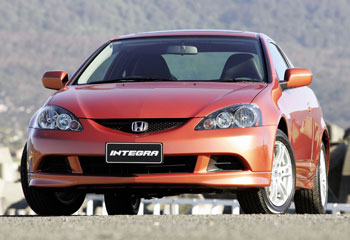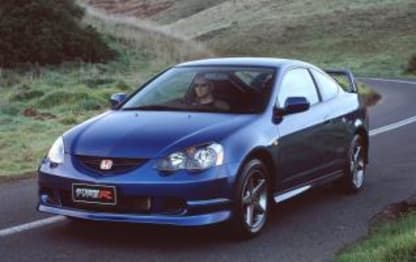
Used Honda Integra review: 2003-2007
- Honda Integra
- Honda Integra 2003
- Honda Integra 2004
- Honda Integra 2005
- Honda Integra 2006
- Honda Integra 2007
- Honda Integra Reviews
- Honda Reviews
- Honda Coupe Range
- Coupe
- Honda
- Used Car Reviews
- Buying tips

The return of Honda to the sporty coupe field with the petrol-electric CR-Z has rekindled interest in the Japanese marque long known for its sporting successes.
As a follow on from that buyers are starting to take an interest in other, sadly superseded, sports models from Honda. And in particular the Integra range.
All Honda Integras are built to a high quality in the Japanese manner and the combination of sportiness and quality means they retain their value well. Resales may further increase due to the aforementioned revival in interest, no promises though...
Honda Integra can be confusing as it changed its character on more than one occasion over the 15 years it was on sale in Australia from 1993. The positive side of that confusion is that many will find an Integra to suit their particular needs. Because you can get either an attractive cruiser, a full-on sports machine, or somewhere in between.
Integra was almost a four-seater in its earlier periods, prior to 2001, and can be used as a nice family machine while the junior travellers are still small. This makes a good compromise for the person who wants a good looking coupe, but who is forced by financial circumstances in the direction of practicality.
At the other end of the scale, the third-generation Honda Integra Type R, is a semi-race machine. While it had been on sale in Japan for a long time the Integra Type R didn’t reach Australia until August 2000, and even then only in limited numbers.
It's a really hot little beast aimed at the serious driver. Those wanting a comfortable cruiser should look elsewhere as this Type R has no compromise suspension settings.
Having introduced us to the delights of a genuine sports machine in that first Type R, Honda went and spoiled things with the fourth-generation, launched in August 2001. It is a softer car than its predecessor, though still reasonably easy to punt hard if you put your mind to it.
It wasn’t until October 2004 that Honda Australia woke up to itself and brought in another ‘proper’ sports Integra, this time tagged as the Type S. Now you can understand why the word confusing appears above...
Engines are 1.8 litres until the fourth-generation model of 2001, when the capacity climbed to 2.0 litres. However, Honda's ability to get big power from smallish engines is renowned and the hottest of them all, the limited edition Type R of 2000 managed a hefty 141 kW from its 1.8 litres.
 Transmission choices are five-speed manual in most models, with the high-performance Type R and Type S getting six-speed manuals.
Transmission choices are five-speed manual in most models, with the high-performance Type R and Type S getting six-speed manuals.
Four-speed automatic transmissions with a conventional change were offered until the 2001 fourth-generation Integra arrived with a five-speed auto using sequential manual overrides.
Even the standard Honda Integras handle pretty well, with good turn-in and not too much understeer if pushed hard.
The hot sports models are amazingly good for front-wheel drive cars, but can be harsh in their ride. There is a good number of Honda dealers Australian wide, with this Japanese company being reasonably well represented in country areas.
Spare parts and servicing are usually well priced, with Honda having put some hard work into pulling prices down a few years back when it had a reputation for charging top dollar for spare bits.
Insurance charges are about average for a sporting coupe, meaning fairly expensive but not outrageously so. Few companies seem to understand that there are some really hot variants amongst them.
The Integra suffered from the general decline in popularity of sports coupes that began early in the 21st century. Though it hung on for longer than some of its competitors, production eventually ceased in 2007.
WHAT TO LOOK FOR
Beware of the Honda Integra Type R that has been thrashed on race tracks, or traffic-light drag racing.
Look for a body kit, extra instruments or a large exhaust tailpipe extension, these may be a sign of hard driving, though many dress up their cars with go-faster.
Excessive brake-pad dust, usually at its worst on the insides of the front wheels and callipers, is another indication of hard driving.
Check for repairs to crash damage by looking for paint that doesn’t match correctly from panel to panel. Ripples in the panels, easiest to spot while looking lengthways along them in good light, are another solid cue. If in doubt, call in an expert.
Make sure that the engine starts properly and idles easily. These sports engines are complex items, particularly for their day, and can be expensive to repair. They really should be checked by a Honda dealer, or at least a specialist technician from a motoring association.
Pay attention to the transmission during your road test and be sure it works smoothly and easily with a minimum of noise.
Look over the interior for signs of damage. Though they usually age well they can suffer rough treatment. Listen for squeaks or rattles inside the car during the test drive, a rough road will magnify.
CAR BUYING TIP
Coupes aimed at cruising buyers may be thrashed, and hot coupes may be driven gently - there’s no logic in this market segment. So don’t jump to conclusions, get a full technical inspection before buying.
Pricing
| Year | Price From | Price To |
|---|---|---|
| 2007 | $6,710 | $11,880 |
| 2006 | $5,610 | $9,900 |
| 2005 | $5,170 | $9,460 |
| 2004 | $3,410 | $10,670 |
| 2003 | $3,410 | $10,670 |
Pricing guides
Range and Specs
| Vehicle | Specs | Price* | |
|---|---|---|---|
| Luxury | 2.0L, ULP, 5 SP MAN | $3,410 – 5,390 | 2003 Honda Integra 2003 Luxury Pricing and Specs |
| (base) | 2.0L, ULP, 5 SP SEQ AUTO | $4,730 – 6,930 | 2003 Honda Integra 2003 (base) Pricing and Specs |
| Type-R | 2.0L, ULP, 6 SP MAN | $7,590 – 10,670 | 2003 Honda Integra 2003 Type-R Pricing and Specs |
$4,730
Lowest price, based on third party pricing data







